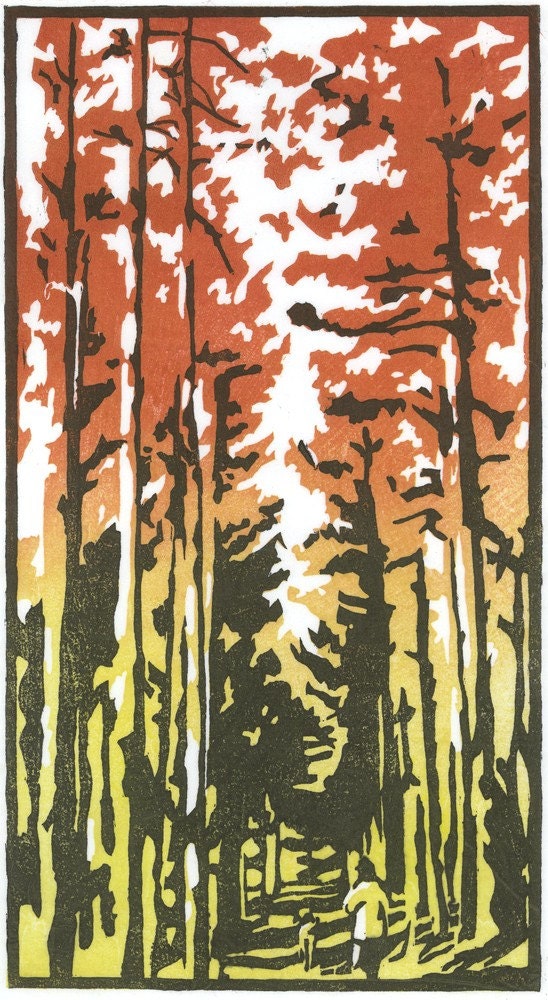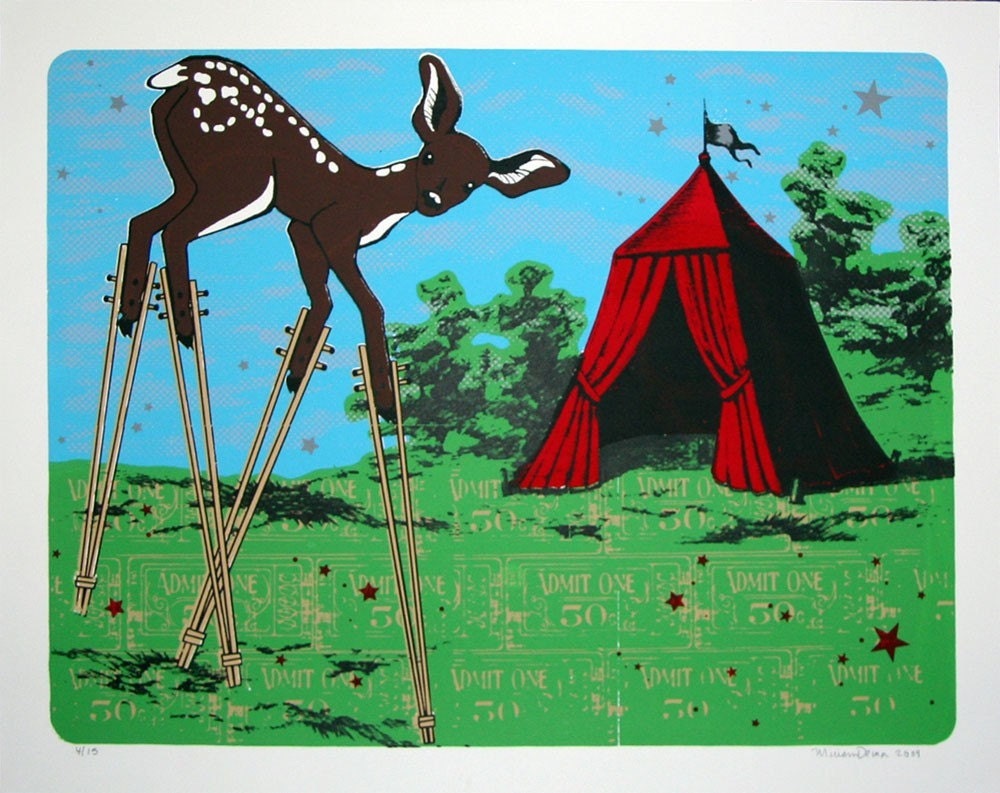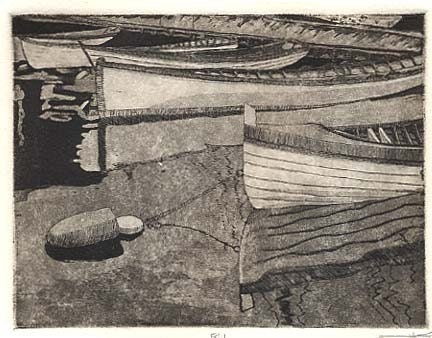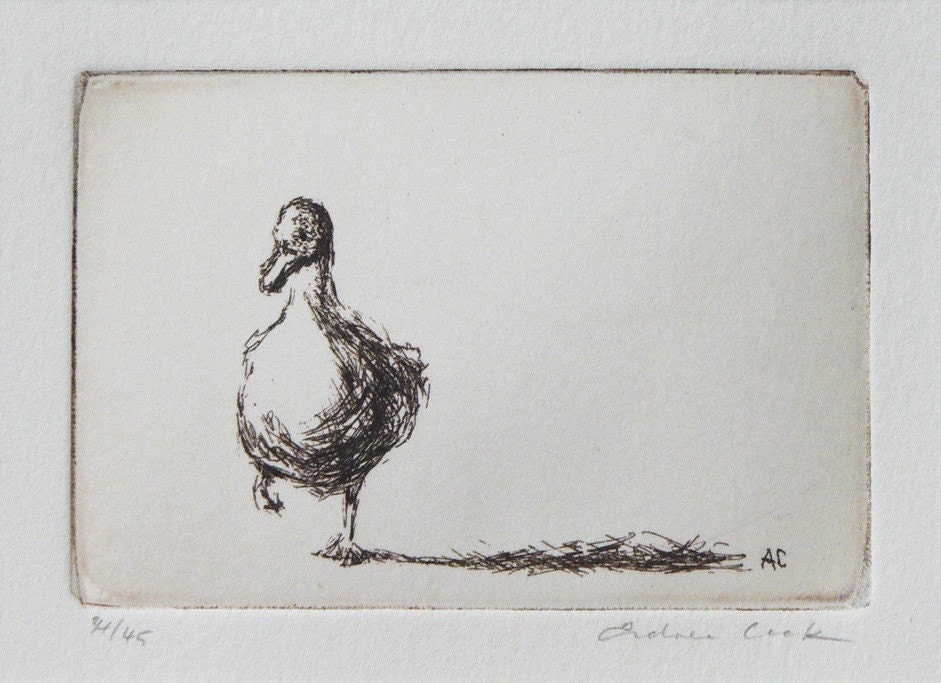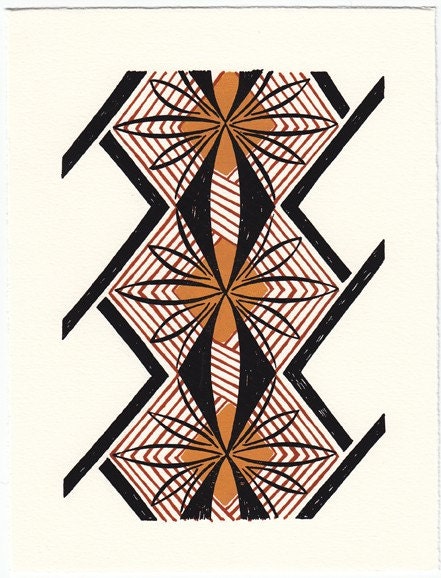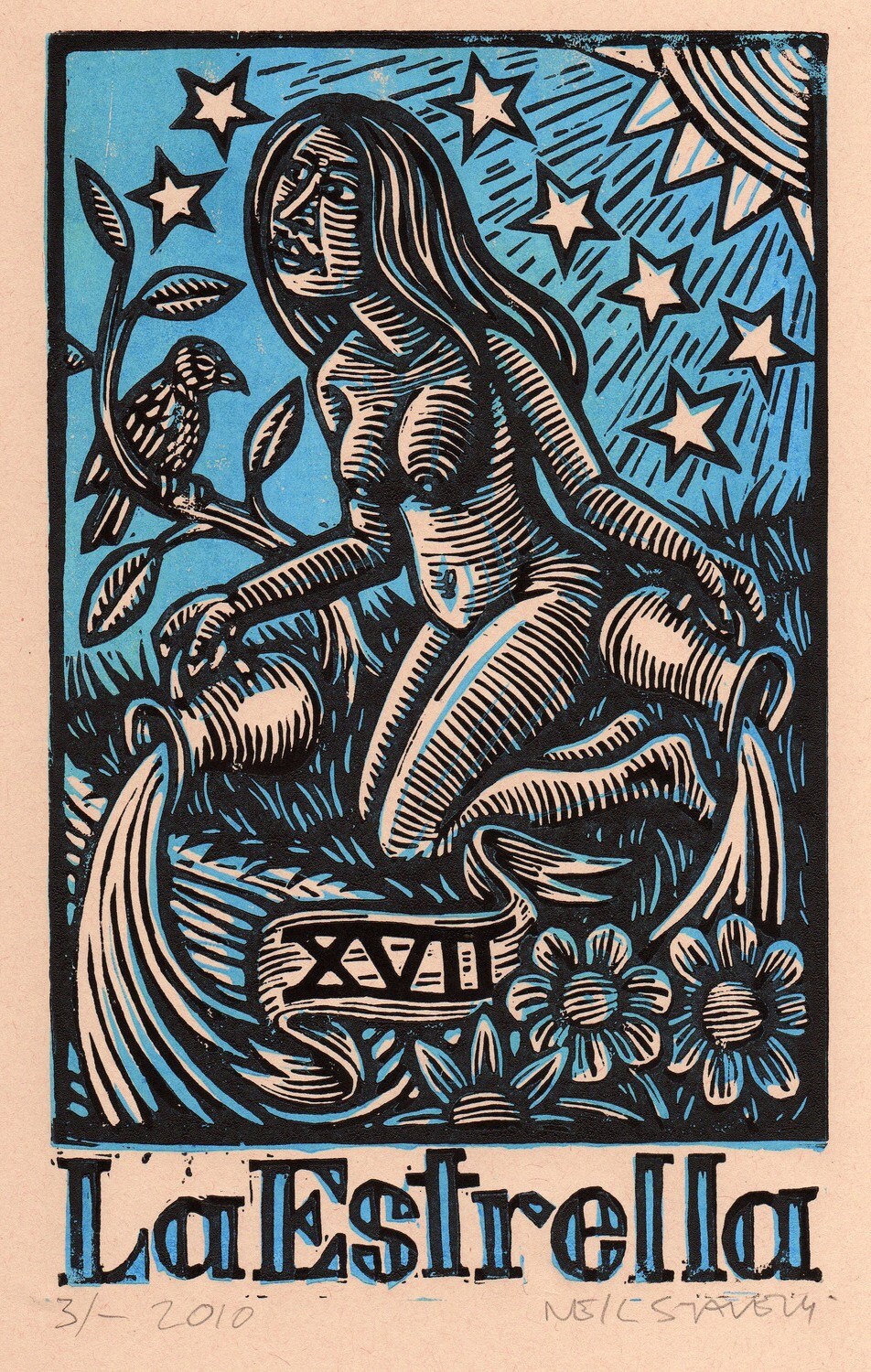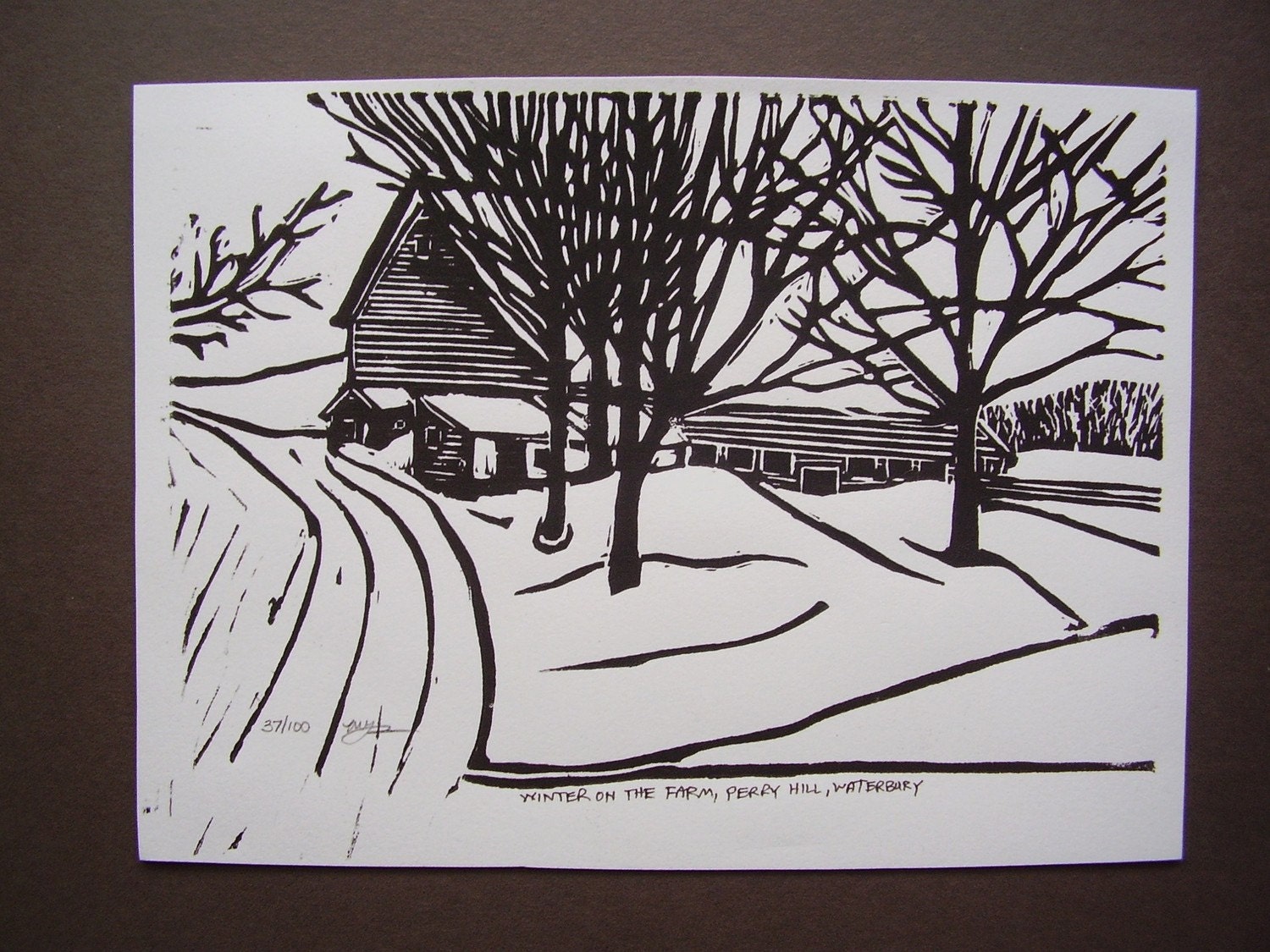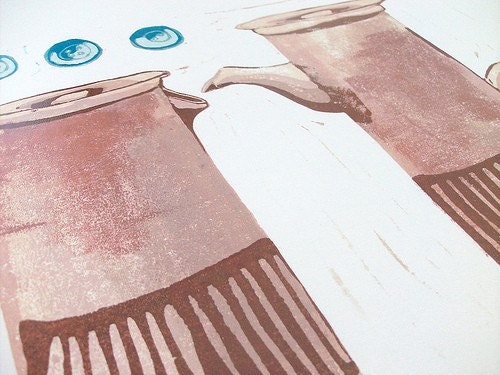Links to Mike's Etsy shop and Blog at the end of this interview.
Biography
I am an artist/printmaker living in Christchurch on the glorious South Island of New Zealand. I have been here for a year now and prior to that I was living in Portland, Oregon. Our move was precipitated by our sense of adventure and to take a break from the chaos of American life and to begin raising our children in a calmer, more peaceful place. I have been a practicing artist for nearly 15 years and during that time I have done a lot of teaching at art schools, community colleges and other venues. (NOTE - there is more on Mike's blog, linked below, regarding his move to New Zealand and how it has impacted his artistic pursuits - a very good read).
Why printing?
I love process. I love learning new techniques. I love drawing. All of these things drive my art making and printmaking fills those needs oh so very well.
What is your favorite print medium and why?
Etching because it rules the universe with its awesomeness. It is direct and very physical and it allows for an endless amount of mark making. You can do anything with etching.
How long have you been printing and how has your work evolved?
I made my first print back in 1988 at Amherst College in Massachusetts. I have been hooked ever since. My vision of what my prints should look like has changed very little over the years, to be honest. I am very focused on producing mainly realistic, slightly romantic visions of the natural world. I have dabbled stylistically in other areas but this way of working just holds the most meaning for me. A genuine, faithful homage to the natural world is what I’m after.
What or Who influences your work?
George Inness, Rembrandt, Durer, Rubens, and Oregon artist James Lavadour are all artists I look at continuously and admire greatly.
How do your promote your work?
I sell on Etsy, Artfire and I just started an art blog but I don’t “promote” stuff there, just vent and play around with art related themes. I also have work in galleries here in New Zealand and back in the US. (More on this on Mike's blog, linked below).
Any good printing tips or funny printing stories (or both??)
Printmaking is hard. Getting comfortable with it takes many years if you are doing it right. As far as “funny” stories go, I don’t really have any but I have plenty of disgusting ones to share. It’s Halloween time back in the US but I just can’t bring myself to share them.....
Mike's Etsy Shop
Mike's Blog
Printmaking artists with work on Etsy, the online source for hand made works of art. All members have work using original, hand-pulled printmaking techniques for sale in their shop.
Sunday, October 31, 2010
Thursday, October 28, 2010
New Printsy Feature
Starting soon, we will be alternating our regular printsy interviews with a new feature about printing tips and techniques. If you have a printing technique you would like to share, have done some step by step demos and documented them, or even want to pose a general question about technique then please convo AnniePod so we can get the ball rolling on this new feature.
Also, if you are a new member of Printsy and have not been interviewed yet, an old time member that hasn't been interviewed since the beginning of the blog, then also get in touch with me. Diane Podolsky (AnniePod)
Also, if you are a new member of Printsy and have not been interviewed yet, an old time member that hasn't been interviewed since the beginning of the blog, then also get in touch with me. Diane Podolsky (AnniePod)
Labels:
printing tips,
Printsy Interviews,
printsy members,
techniques
Sunday, October 24, 2010
Ali Sabin
Links to Ali's Etsy site, facebook page, and blog site are at the bottom of this interview.
Bio:
I'm Ali Sabin of IPullPrints. I'm a web developer by weekday and printmaker by night, weekend, holiday or any other chance I can snag. I make ole timey prints; ole timey by craft, technique, design, and theme. I stick (mostly) to block printing and adore every second of the process.
Origins/Process:
Fascinated with replication and mid-century advertisement, I strayed from my origins in painting/drawing (BFA withstanding) and set up a tiny area in my half-renovated kitchen for printing. I carved and pulled my way into covering my entire kitchen with tiny "on-location" prints, all over the walls, hanging like used-car-lot flags from tables, counters and even the ceiling. More contented with the process than the product, I never intended on selling anything till a successful artist friend suggested I rid myself of these hundreds of prints...and so it continues.
As mentioned I'm renovating my 1950's asbestos cottage and its become, well, a giant studio. I generally use every room in my home for some printing purpose: the yard for thinking, drawing, the den for carving/inking/etc, the kitchen for drying, the restroom for rinsing tools and blocks, the bedroom for photos and staging, and the puppy's room for organization, cataloging and storage.
Best/Worst About Printing:
I always lose myself in the carving step of the print process. Addicted to tedium, I could carve for hours and never tire. I could, however, live without the packaging portion. As a result, I've adjusted to printing on wood panels (links were here)
Inspiration:
My inspiration changes every day and, said change, is triggered by anything and everything; by an old drug-store sign, a cigar or candy wrapper, an unconventionally beautiful person, an old building, vehicle or bicycle. I "covet what [I] see everyday".
Changes:
After three years of printmaking, I've definitely allowed myself to go full-throttle with the detailing of my work. At first, I stuck with cleaner, more bauhaus-styled designs but now, I throw caution out the door and try to get as detailed as possible. I've ruined many blocks trying to carve-out itsy teensy nooks and crannies but see it more as useful experience than failure. I, very fortunately, studied art installation and watercolor under the great Robert Stackhouse and will never forget his emphasis on working in a more process-oriented mindset than trying to foresee a predictable outcome (not directly quoted of course). I've carried that snippet with me for over ten years and it hasn't failed.
Slumps:
The aforementioned adage also helps my through the slumps. A while ago, I was terrified of letting go of my work: "what if I never make anything as 'good' as this piece is?" Now, I rarely hold onto anything I make. Whether it’s good, bad, frustrating, whatever, it’s out of my hands, literally and metaphorically, gone, out the door either sold or donated. It seems that the more I'm surrounded by my old work, the longer my slumps sustain.
Promotion:
To promote I rely on local shows, donating pieces, facebook, etsy, associations ie, Printsy) gifting, etc.) At shows, I generally have some kind of kitchy gimmick like a scratch-n-win game where I give away a bunch of prints but its alot of fun, folks seem to dig it.
Lastly, advice:
Don't forget to do your interviews in a timely fashion. Do as I say, not as I do
Ali's Etsy Site
Ali's Facebook Page
Ali's Blog
Bio:
I'm Ali Sabin of IPullPrints. I'm a web developer by weekday and printmaker by night, weekend, holiday or any other chance I can snag. I make ole timey prints; ole timey by craft, technique, design, and theme. I stick (mostly) to block printing and adore every second of the process.
Origins/Process:
Fascinated with replication and mid-century advertisement, I strayed from my origins in painting/drawing (BFA withstanding) and set up a tiny area in my half-renovated kitchen for printing. I carved and pulled my way into covering my entire kitchen with tiny "on-location" prints, all over the walls, hanging like used-car-lot flags from tables, counters and even the ceiling. More contented with the process than the product, I never intended on selling anything till a successful artist friend suggested I rid myself of these hundreds of prints...and so it continues.
As mentioned I'm renovating my 1950's asbestos cottage and its become, well, a giant studio. I generally use every room in my home for some printing purpose: the yard for thinking, drawing, the den for carving/inking/etc, the kitchen for drying, the restroom for rinsing tools and blocks, the bedroom for photos and staging, and the puppy's room for organization, cataloging and storage.
Best/Worst About Printing:
I always lose myself in the carving step of the print process. Addicted to tedium, I could carve for hours and never tire. I could, however, live without the packaging portion. As a result, I've adjusted to printing on wood panels (links were here)
Inspiration:
My inspiration changes every day and, said change, is triggered by anything and everything; by an old drug-store sign, a cigar or candy wrapper, an unconventionally beautiful person, an old building, vehicle or bicycle. I "covet what [I] see everyday".
Changes:
After three years of printmaking, I've definitely allowed myself to go full-throttle with the detailing of my work. At first, I stuck with cleaner, more bauhaus-styled designs but now, I throw caution out the door and try to get as detailed as possible. I've ruined many blocks trying to carve-out itsy teensy nooks and crannies but see it more as useful experience than failure. I, very fortunately, studied art installation and watercolor under the great Robert Stackhouse and will never forget his emphasis on working in a more process-oriented mindset than trying to foresee a predictable outcome (not directly quoted of course). I've carried that snippet with me for over ten years and it hasn't failed.
Slumps:
The aforementioned adage also helps my through the slumps. A while ago, I was terrified of letting go of my work: "what if I never make anything as 'good' as this piece is?" Now, I rarely hold onto anything I make. Whether it’s good, bad, frustrating, whatever, it’s out of my hands, literally and metaphorically, gone, out the door either sold or donated. It seems that the more I'm surrounded by my old work, the longer my slumps sustain.
Promotion:
To promote I rely on local shows, donating pieces, facebook, etsy, associations ie, Printsy) gifting, etc.) At shows, I generally have some kind of kitchy gimmick like a scratch-n-win game where I give away a bunch of prints but its alot of fun, folks seem to dig it.
Lastly, advice:
Don't forget to do your interviews in a timely fashion. Do as I say, not as I do
Ali's Etsy Site
Ali's Facebook Page
Ali's Blog
Thursday, October 21, 2010
Who's Printsy This Week
Sunday, October 17, 2010
Niki Bañados
 Links to Niki's Etsy site, website, and blog are at the bottom of this interview.
Links to Niki's Etsy site, website, and blog are at the bottom of this interview.How did you get started in printmaking?
I did one printmaking subject at university, as an elective. Our class took on the role of custom printers, under the name Cicada Press. We got to edition the works of well known local artists – and this responsibility of course meant we had to get proficient, fast! Aside from editioning other people’s work, we also got to do a couple of our own images. I loved etching immediately because it is forgiving of (or should I say it complements) my messy, finicky drawing style, so when uni was over, I looked for a studio where I could continue doing it.
Describe where you work.
I do my printing at an open studio called Warringah Printmakers Studio. They support safe practices which means there is not a drop of acid to be found, and we etch with copper sulphate. It’s good to know I’m lowering my chances of developing diseases later in life because of the processes, but it’s also frustrating sometimes because it’s not as stable and predictable as acid. Still learning!
What's your favourite printmaking process?
Etching on zinc. There’s enough possibilities with it that I haven’t felt the need to experiment further… yet.
What's your creative process for any given print?
First the idea gets drawn in a notebook. This usually happens within 30 seconds because I’m terrified I’ll forget it. A few months later I’ll stumble across it again and if it still looks attractive, I will look up some images on google, or photograph my own, to use as a reference for drawing. I then draw straight onto the (hard grounded surface of the) plate.
What do you enjoy most about printmaking?
Others find the long etching process tiresome, but it’s what I like best. I like seeing the physical reaction of the acid bubbling the plate away, watching the plate get shiny as the ink is wiped off, and peeling the paper away from the plate.
What's your least favorite part of the process?
Peeling the paper away from the plate and realising how many mistakes you’ve made! Getting dry hands from constant washing is also annoying. The rest is fine. I even enjoy cleaning the plate off.
What are your inspirations?
Other etchers. They show me how much I still don’t know and how much I could possibly do if I spent more time at it. Also I like the MCA in Sydney, and all the little galleries in the side streets that line Oxford Street (also in Sydney). These don’t directly reflect in my work either in subject matter or style, but are useful as a reminder to me to keep making art.
How has your work changed and evolved since you started?
I’ve only just started! I will definitely be looking into some evolution, but only once I’ve gained enough level-up points.
How do you get past creative slumps?
By looking at what I know and working from that, even if it’s not immediately creative or exciting. It can be helpful to just have a starting point from which better things can emerge, especially because I tend to get ideas by working, rather than by sitting around moping.
How do you promote your work?
Etsy, facebook, flickr. At the moment I don’t have enough actual content, so I’m focusing my efforts on that. Later I’d like to have a stall in one or a few of Sydney’s many markets, and to promote my work via word of mouth through the people I know.
Any other comments or advice for others who want to try making hand-pulled prints?
Everyone knows what sculpture and painting and photography is, but no one knows about printmaking! Why not!? Show your friends and family, take the time to describe some of the work that goes into it, and what makes it unique. Imagine a world where people no longer get printmakers mixed up with inkjet and laser printers.
Niki’s Etsy Shop
Niki’s Blog
Niki’s Web Site
Friday, October 15, 2010
Who's Printsy This Week
Sunday, October 10, 2010
Camille Riner
Camille's Etsy shop link at the bottom of this interview
Biography
Camille Riner has a BFA from the University of South Dakota and her MFA in printmaking from the University of Wisconsin-Madison. Before moving back to South Dakota she taught art and design at Southwestern Michigan College in Dowagiac, Michigan. Currently she works in her studio creating artists books, pulling prints and designing photographic books with her husband, photographer Paul Horsted.
How did you get started in printmaking?
I didn't know what printmaking was when I started college. But I heard so much about the professor of the printmaking class and saw a lot of excitement in that part of the art department that I signed up for my first class, lithography. Lithography threw me for a loop; this was a whole new challenging, exciting way to work for me. It seemed there was so much you could do with the medium. I was hooked and decided to major in printmaking. The experience was a great one not only for the things I learned from my professor and TA but also from the diverse mix of visiting printmakers that came to the school that I was able to work with. Through this experience I could see what the life of an artist could be like by watching and getting to know these artists.
Describe where you work.
My studio is a converted garage, previous owner's occupant, a horse. My husband and I took out the doors, added walls and windows and cleaned and painted the cement floor and I began to set up work stations. I have a great view out from my computer desk of the Buckhorn Range and three studio mates, two feathered ones that squawk when I make phone calls and one that tapes artwork on every empty surface when she is not in elementary school.
What's your favorite printmaking process?
Relief printing! It just has that special something that I was attracted to the first time I saw it, the pattern, contrast, and boldness of line. I also like the directness of carving and the magic that happens when you start to layer print runs on the press.
What's your creative process for any given print?
I am a big believer in keeping a sketchbook/journal. I put all kinds of things in these: a phrase that caught my fancy, paragraphs from a current book I am reading or a pattern I saw. I use these idea banks to combine images and ideas. I start with small sketches and then make a final size sketch in pencil, going over it in marker when I am done to note the darks, lights, patterns and textures.
What do you enjoy most about printmaking?
The process; no, the beautiful surfaces; no, camaraderie of printmakers; no, the possibilities in making multiples.......I guess I like pretty much all of it.
What's your least favorite part of the process?
Clean up!
What are your inspirations?
I enjoy looking at prints and illustrations, reading poetry that distills the meaning down to the least amount of words, seeing all the great textures and colors when I take a walk, watching indie films, and reading.
How has your work changed and evolved since you started?
For me, I think, when you begin your "voice" is made up of technical exercises and is strongly influenced by trying to imitate people that you admire. As you continue to work you get to know your working style and how to best to communicate your ideas. These along with your talents and quirks become your unique voice. I love the beautiful development of form I see some intaglio and litho people accomplish. In college I tried to emulate that style but it is not a good fit to my temperament or ideas. My hands/soul tends to create work that is quirky, stylized and esoteric.
How do you get past creative slumps?
I have found I need to just ride them out. I tend to look at and write in my sketchbooks or change my surroundings. Sometimes that means cleaning out the studio! A clean studio with new things tacked on the wall and a few ideas laid out on my work table help to inspire me. Making a trip to see new exhibits, visiting old museum favorites, walking in the woods with my sketchbook, learning about someone else's passion, hearing a new inspiring musician all help adjust my perspective which sometimes turns into new ideas.
Long ago I had an artist friend tell me a good hint. When she was down or tired, she went to the studio with the idea that she was going to give herself an hour to work. Some days this was the only way to get her into her studio, knowing it would be just for an hour. Most times however after she started working she was able to get involved and her ideas and motivation would return. It is easy to let the call of the things outside your studio detract you from working especially if it is to just be in your studio to think.
For me there are two parts to creating work, collecting and developing.
Some times are ripe for collecting, you are reading many things that are challenging your ideas, going through a new experience, traveling, or just aware of things in a different way that you experience them more acutely. In these periods I try to write down, copy or collect things that inspire or provoke me.
At other times you develop ideas, maybe for a deadline or just because. During this time I return to my sketchbooks and revisit these thoughts and ideas until I pick the ones that I want to develop. I do sketches of how they could be put together, what perspective I want to use and maybe look up some additional references for things I want to include. For me this is a drawing time with lots of erasing.
So if I am not in one mode of working I am in another, or try to be. I guess having choices is good for me.
How do you promote your work?
I am in transition from doing exhibitions and galleries to more things on-line. The development of more internet networks has been good, I live in a rural location and this has enabled me to connect with other artists and see more contemporary work. I'm not sure how all this will work out but there seems to be some great possibilities.
Any other comments or advice for others who want to try making hand-pulled prints?
Take a community education class or visit a print show opening to learn about the different print media and meet other printers. Printmakers are usually a pretty welcoming group and like to share knowledge. I find that taking a workshop where you go and stay for the week a great way to submerge yourself in a new medium and meet others in the field. My particular favorite is the Frogman's Print and Paper Symposium.
Camille’s Etsy Site
Biography
Camille Riner has a BFA from the University of South Dakota and her MFA in printmaking from the University of Wisconsin-Madison. Before moving back to South Dakota she taught art and design at Southwestern Michigan College in Dowagiac, Michigan. Currently she works in her studio creating artists books, pulling prints and designing photographic books with her husband, photographer Paul Horsted.
How did you get started in printmaking?
I didn't know what printmaking was when I started college. But I heard so much about the professor of the printmaking class and saw a lot of excitement in that part of the art department that I signed up for my first class, lithography. Lithography threw me for a loop; this was a whole new challenging, exciting way to work for me. It seemed there was so much you could do with the medium. I was hooked and decided to major in printmaking. The experience was a great one not only for the things I learned from my professor and TA but also from the diverse mix of visiting printmakers that came to the school that I was able to work with. Through this experience I could see what the life of an artist could be like by watching and getting to know these artists.
Describe where you work.
My studio is a converted garage, previous owner's occupant, a horse. My husband and I took out the doors, added walls and windows and cleaned and painted the cement floor and I began to set up work stations. I have a great view out from my computer desk of the Buckhorn Range and three studio mates, two feathered ones that squawk when I make phone calls and one that tapes artwork on every empty surface when she is not in elementary school.
What's your favorite printmaking process?
Relief printing! It just has that special something that I was attracted to the first time I saw it, the pattern, contrast, and boldness of line. I also like the directness of carving and the magic that happens when you start to layer print runs on the press.
What's your creative process for any given print?
I am a big believer in keeping a sketchbook/journal. I put all kinds of things in these: a phrase that caught my fancy, paragraphs from a current book I am reading or a pattern I saw. I use these idea banks to combine images and ideas. I start with small sketches and then make a final size sketch in pencil, going over it in marker when I am done to note the darks, lights, patterns and textures.
What do you enjoy most about printmaking?
The process; no, the beautiful surfaces; no, camaraderie of printmakers; no, the possibilities in making multiples.......I guess I like pretty much all of it.
What's your least favorite part of the process?
Clean up!
What are your inspirations?
I enjoy looking at prints and illustrations, reading poetry that distills the meaning down to the least amount of words, seeing all the great textures and colors when I take a walk, watching indie films, and reading.
How has your work changed and evolved since you started?
For me, I think, when you begin your "voice" is made up of technical exercises and is strongly influenced by trying to imitate people that you admire. As you continue to work you get to know your working style and how to best to communicate your ideas. These along with your talents and quirks become your unique voice. I love the beautiful development of form I see some intaglio and litho people accomplish. In college I tried to emulate that style but it is not a good fit to my temperament or ideas. My hands/soul tends to create work that is quirky, stylized and esoteric.
How do you get past creative slumps?
I have found I need to just ride them out. I tend to look at and write in my sketchbooks or change my surroundings. Sometimes that means cleaning out the studio! A clean studio with new things tacked on the wall and a few ideas laid out on my work table help to inspire me. Making a trip to see new exhibits, visiting old museum favorites, walking in the woods with my sketchbook, learning about someone else's passion, hearing a new inspiring musician all help adjust my perspective which sometimes turns into new ideas.
Long ago I had an artist friend tell me a good hint. When she was down or tired, she went to the studio with the idea that she was going to give herself an hour to work. Some days this was the only way to get her into her studio, knowing it would be just for an hour. Most times however after she started working she was able to get involved and her ideas and motivation would return. It is easy to let the call of the things outside your studio detract you from working especially if it is to just be in your studio to think.
For me there are two parts to creating work, collecting and developing.
Some times are ripe for collecting, you are reading many things that are challenging your ideas, going through a new experience, traveling, or just aware of things in a different way that you experience them more acutely. In these periods I try to write down, copy or collect things that inspire or provoke me.
At other times you develop ideas, maybe for a deadline or just because. During this time I return to my sketchbooks and revisit these thoughts and ideas until I pick the ones that I want to develop. I do sketches of how they could be put together, what perspective I want to use and maybe look up some additional references for things I want to include. For me this is a drawing time with lots of erasing.
So if I am not in one mode of working I am in another, or try to be. I guess having choices is good for me.
How do you promote your work?
I am in transition from doing exhibitions and galleries to more things on-line. The development of more internet networks has been good, I live in a rural location and this has enabled me to connect with other artists and see more contemporary work. I'm not sure how all this will work out but there seems to be some great possibilities.
Any other comments or advice for others who want to try making hand-pulled prints?
Take a community education class or visit a print show opening to learn about the different print media and meet other printers. Printmakers are usually a pretty welcoming group and like to share knowledge. I find that taking a workshop where you go and stay for the week a great way to submerge yourself in a new medium and meet others in the field. My particular favorite is the Frogman's Print and Paper Symposium.
Camille’s Etsy Site
Labels:
camaraderie of printmakers,
Camille Riner,
Frogman's Print and Paper Symposium,
Linoblocks,
making multiples,
Rural artists,
South Dakota Artists,
studio cleanup,
University of South Dakota
Saturday, October 9, 2010
Survey
Printsy has been selected to participate in a survey that explores creative entrepreneurship. Your team was one of those chosen from among Etsy teams whose members produce and sell original crafts and artwork. The study is being conducted by Kristine Kuhn, Associate Professor, and Tera Galloway, Ph.D. student, in the College of Business at Washington State University.
We are requesting that you post the attached survey invitation to your team blog and/or send the invitation out as an email to team members of Printsy. The survey questions are as follows:
1. How long have you been selling your handiwork on Etsy? What were your primary motivations in deciding to start this business? To what extent have your goals (financial, creative, etc.) been fulfilled?
2. Do you receive support, ideas, or help from other Etsy members? Please describe in terms of whether this information has affected the type of products you sell (designs, styles, etc.) and/or how you run your business (marketing, technical support, etc.)
3. Do you provide support, ideas, or help to other Etsy members? Please describe.
4. Why did you join an Etsy team/s? Please describe any advantages and/or disadvantages of team membership.
5. Approximately what percentage of your income comes from selling your handiwork? Is this substantially more than, less than, or about what you expected when you first started this business? Do you expect your revenues to change significantly over the next two years?
We are asking respondents to simply email their responses to these five questions to kmkuhn [!at] wsu.edu. Your team’s participation will help provide a greater understanding of the role of information sharing among creative entrepreneurs. All responses will be kept fully confidential, and no individual names, team names, or personally identifying information will be released. If you are interested in the survey results, let us know and we can share general response trends across teams with you (although not individual responses).
Although we do not have the budget to compensate all respondents for their time, we will select 10 people at random from all those who respond to this request by October 15th, and send them $20 Amazon gift cards to the email address used in their response.
If you have any questions, please contact us at the email address or phone number below.
Sincerely,
Kristine M. Kuhn
Associate Professor
Email: kmkuhn [!at] wsu.edu
Department of Management
College of Business
Washington State University
Pullman, WA 9914-4736
Tel: 509-335-1694
Tera Galloway
Ph.D student
Email: teralynn [!at] wsu.edu
Department of Management
College of Business
Washington State University
Pullman, WA 99164-4736
We are requesting that you post the attached survey invitation to your team blog and/or send the invitation out as an email to team members of Printsy. The survey questions are as follows:
1. How long have you been selling your handiwork on Etsy? What were your primary motivations in deciding to start this business? To what extent have your goals (financial, creative, etc.) been fulfilled?
2. Do you receive support, ideas, or help from other Etsy members? Please describe in terms of whether this information has affected the type of products you sell (designs, styles, etc.) and/or how you run your business (marketing, technical support, etc.)
3. Do you provide support, ideas, or help to other Etsy members? Please describe.
4. Why did you join an Etsy team/s? Please describe any advantages and/or disadvantages of team membership.
5. Approximately what percentage of your income comes from selling your handiwork? Is this substantially more than, less than, or about what you expected when you first started this business? Do you expect your revenues to change significantly over the next two years?
We are asking respondents to simply email their responses to these five questions to kmkuhn [!at] wsu.edu. Your team’s participation will help provide a greater understanding of the role of information sharing among creative entrepreneurs. All responses will be kept fully confidential, and no individual names, team names, or personally identifying information will be released. If you are interested in the survey results, let us know and we can share general response trends across teams with you (although not individual responses).
Although we do not have the budget to compensate all respondents for their time, we will select 10 people at random from all those who respond to this request by October 15th, and send them $20 Amazon gift cards to the email address used in their response.
If you have any questions, please contact us at the email address or phone number below.
Sincerely,
Kristine M. Kuhn
Associate Professor
Email: kmkuhn [!at] wsu.edu
Department of Management
College of Business
Washington State University
Pullman, WA 9914-4736
Tel: 509-335-1694
Tera Galloway
Ph.D student
Email: teralynn [!at] wsu.edu
Department of Management
College of Business
Washington State University
Pullman, WA 99164-4736
Thursday, October 7, 2010
Who's Printsy This Week
Sunday, October 3, 2010
Karin Bruckner
Karin's Etsy site and Facebook Page are at the bottom of this interview.
Brief Bio
I am an architect by training. I studied in Zurich, Switzerland and Munich, Germany - the places I was born and raised in - before coming to New York, where I completed my studies and worked as an architect in the offices of Richard Meier and Philip Johnson. Once I opted for family life though, my focus shifted and I began to gradually embrace my inner artist.
How did you get started in printmaking?
A few years back I took up printmaking classes. I always felt a special affinity for prints and with the added appeal of working on a 19th century cast-iron printing press it didn’t take long for me to get hooked. I realized that I had found my medium, a perfect fusion of art and architecture. Printmaking has been my focus since 2006.
Describe where you work.
I split my printing time between two places. At home my dining room doubles as my work space. Equipped with a hand-me-down 12”x24” Takach printing press and a sizable table I work on small size prints and long narrow formats there. Over the past year I have been fortunate to occasionally share a friend’s studio space with a larger printing press, which allows me to work on pieces up to 22”x36” inches in size.
What's your favorite printmaking process?
I began with Monoprints/Monotypes - every piece is a unique, one-of-a-kind original, no two are alike and one leads to another and another…Given my work circumstance I like the idea of working with non-toxic materials, that clean up easily. I use Akua water-based inks and various material on acrylic plates, which lend themselves to a wide range of experimentation. The prints are hand-pulled onto beautiful archival printmaking paper such as Hahnemuehle or BFK Rives.
What's your creative process for any given print?
It almost always begins with making a mark in print. There is nothing like making a mark and seeing where it takes you, finding the hidden inside and bringing it forth. A big part of my work derives from imprints of natural, found and man-made matter - hence the name ‘kbmatter’ for my etsy shop. I frequently customize the ready-made, which involves ‘upcycling’ some found object, exploring shapes, textures and effects. I add elements by making my own paper or mylar templates of images I either drew or photographed. A piece can evolve into an assemblage of printing, drawing, painting, ink transfer and collage. In layering these elements, usually a narrative emerges. The final result is often not so much a classic monoprint but rather a combination of techniques, a kind of printmaking.
The possibilities seem endless and can take you almost anywhere. I like to think that in a way it is not me who is making the art, it is the art making itself through me.
What do you enjoy most about printmaking?
The spontaneity and surprise element of printmaking - a piece ‘becomes’. Despite the increasing experience and awareness of effects, there is always a chance of the unforeseen happening, which can propel you to a different place. Sometimes it is the happy accident that makes the piece.
What's your least favorite part of the process?
Clean-up, mostly. Both set-up and clean-up are rather involved and take time away from limited work time available.
What are your inspirations (other artists, people, places, events, etc.)?
First and foremost contemplating other artists’ work is always hugely inspirational.
I also benefit from sharing a work space and watching a creative process that is different from my own.
Ultimately I find inspiration in lots of places. Material is all around, you take one thing and turn it into something else, things have a second life. The older I get, the more I see.
How has your work changed and evolved since you started?
The opportunity to work in a studio has provided me with the time and space to pin things up and contemplate them at a distance, which helped me to develop the readability of my work enormously. It has enabled me to move from smaller, more intimitate images with more muted colors to larger,bolder ones. It’s also helpful in keeping the complexity of my pieces in check.
How do you get past creative slumps?
Sometimes life interferes and working creatively is next to impossible. Just going to the studio helps me to push myself to get started on something, making another mark, opening up another dialogue with a piece of paper or simply finding another interesting thing.
How do you promote your work?
For now I have my kbmatter shop on etsy and a facebook page just for my art.
Getting online exposure is great and provides easy access . It doesn’t fully bring the work across – the look and feel of the paper is a dimension that’s missing. I have participated in art fairs and auctions and have my portfolios within reach. I do get the best responses and the most sales so far with directly showing my work and talking about it. Having business cards handy is also a good thing.
Any other comments or advice for others who want to try making hand-pulled prints?
You don’t need a press to get started, the back of a spoon will do.
There are many ways to leave a mark or an imprint. Be creative, go where it takes you.
Karin’s Etsy Site
Karin’s Facebook page
Brief Bio
I am an architect by training. I studied in Zurich, Switzerland and Munich, Germany - the places I was born and raised in - before coming to New York, where I completed my studies and worked as an architect in the offices of Richard Meier and Philip Johnson. Once I opted for family life though, my focus shifted and I began to gradually embrace my inner artist.
How did you get started in printmaking?
A few years back I took up printmaking classes. I always felt a special affinity for prints and with the added appeal of working on a 19th century cast-iron printing press it didn’t take long for me to get hooked. I realized that I had found my medium, a perfect fusion of art and architecture. Printmaking has been my focus since 2006.
Describe where you work.
I split my printing time between two places. At home my dining room doubles as my work space. Equipped with a hand-me-down 12”x24” Takach printing press and a sizable table I work on small size prints and long narrow formats there. Over the past year I have been fortunate to occasionally share a friend’s studio space with a larger printing press, which allows me to work on pieces up to 22”x36” inches in size.
What's your favorite printmaking process?
I began with Monoprints/Monotypes - every piece is a unique, one-of-a-kind original, no two are alike and one leads to another and another…Given my work circumstance I like the idea of working with non-toxic materials, that clean up easily. I use Akua water-based inks and various material on acrylic plates, which lend themselves to a wide range of experimentation. The prints are hand-pulled onto beautiful archival printmaking paper such as Hahnemuehle or BFK Rives.
What's your creative process for any given print?
It almost always begins with making a mark in print. There is nothing like making a mark and seeing where it takes you, finding the hidden inside and bringing it forth. A big part of my work derives from imprints of natural, found and man-made matter - hence the name ‘kbmatter’ for my etsy shop. I frequently customize the ready-made, which involves ‘upcycling’ some found object, exploring shapes, textures and effects. I add elements by making my own paper or mylar templates of images I either drew or photographed. A piece can evolve into an assemblage of printing, drawing, painting, ink transfer and collage. In layering these elements, usually a narrative emerges. The final result is often not so much a classic monoprint but rather a combination of techniques, a kind of printmaking.
The possibilities seem endless and can take you almost anywhere. I like to think that in a way it is not me who is making the art, it is the art making itself through me.
What do you enjoy most about printmaking?
The spontaneity and surprise element of printmaking - a piece ‘becomes’. Despite the increasing experience and awareness of effects, there is always a chance of the unforeseen happening, which can propel you to a different place. Sometimes it is the happy accident that makes the piece.
What's your least favorite part of the process?
Clean-up, mostly. Both set-up and clean-up are rather involved and take time away from limited work time available.
What are your inspirations (other artists, people, places, events, etc.)?
First and foremost contemplating other artists’ work is always hugely inspirational.
I also benefit from sharing a work space and watching a creative process that is different from my own.
Ultimately I find inspiration in lots of places. Material is all around, you take one thing and turn it into something else, things have a second life. The older I get, the more I see.
How has your work changed and evolved since you started?
The opportunity to work in a studio has provided me with the time and space to pin things up and contemplate them at a distance, which helped me to develop the readability of my work enormously. It has enabled me to move from smaller, more intimitate images with more muted colors to larger,bolder ones. It’s also helpful in keeping the complexity of my pieces in check.
How do you get past creative slumps?
Sometimes life interferes and working creatively is next to impossible. Just going to the studio helps me to push myself to get started on something, making another mark, opening up another dialogue with a piece of paper or simply finding another interesting thing.
How do you promote your work?
For now I have my kbmatter shop on etsy and a facebook page just for my art.
Getting online exposure is great and provides easy access . It doesn’t fully bring the work across – the look and feel of the paper is a dimension that’s missing. I have participated in art fairs and auctions and have my portfolios within reach. I do get the best responses and the most sales so far with directly showing my work and talking about it. Having business cards handy is also a good thing.
Any other comments or advice for others who want to try making hand-pulled prints?
You don’t need a press to get started, the back of a spoon will do.
There are many ways to leave a mark or an imprint. Be creative, go where it takes you.
Karin’s Etsy Site
Karin’s Facebook page
Subscribe to:
Posts (Atom)











